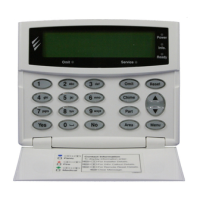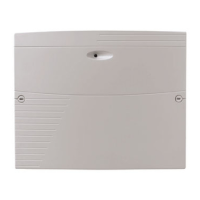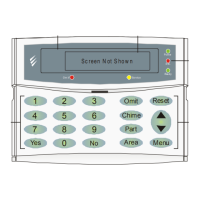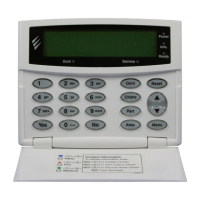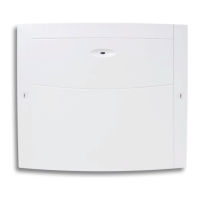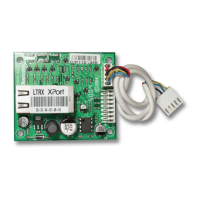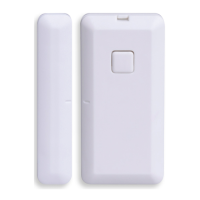Premier 48, 88, 168 & 640 Installation Manual Programming the Control Panel
INS176 59
Expander Areas
Expanders can be assigned to any number of areas,
assigning an expander to an area determines:
• Which areas the speaker output on the expander will
generate tones for i.e. if the expander is assigned to
areas A and C, the speaker will only operate when areas
A or C are in alarm, entry, exit etc.
• Which areas will cause a Tamper alarm when the
expander cover is removed
Expander Location Text
Each expander can be assigned up to 16 characters of text.
This text can be used to describe where the expander is
located within the building.
Text is programmed in a similar way to mobile phones. Select
characters by pressing the corresponding key the
appropriate number of times (to select a character on the
same key, press the
key to move the cursor along).
Expander Auxiliary Input
Each expander has an input that can be programmed for one
of the following options. If not being used, the input must be
programmed as ‘Not Used’ (Default = Not Used).
Not Used
Never monitored by the system.
Auxiliary Tamper
Normally used for monitoring the box tamper of auxiliary
devices such as power supplies etc (remove 0V for Tamper
alarm).
Bell Tamper
Normally used for monitoring Bell Tamper returns (remove 0V
for Tamper alarm).
Remote Reset
Normally used to reset the system/area following an Intruder
alarm (the area must also be programmed for Anti-code
reset) see page 43 for details (apply 0V to reset).
Line Fault +ve
Normally used to indicate a telephone line fault (remove 0V
for Line Fault).
Line Fault -ve
Normally used to indicate a telephone line fault (apply 0V for
Line Fault).
Silence Sounders
Normally used to silence the Internal sounders following an
Intruder alarm and would be used in conjunction with Audio
Verification units (apply 0V to silence).
Global Omit Key
Normally wired to a key switch. When the key switch is activated,
all zones (with the ‘Omit’ attribute) assigned to the same area as
the expander, will be omitted (apply 0V for omit).
Local Omit Key
Normally wired to a key switch. When the key switch is
activated, all zones (with the ‘Omit’ attribute) wired to the
expander, will be omitted (apply 0V for omit).
PSU Monitor
Normally used to monitor a Power Supply for faults, see page
22 for wiring details.
Defer Auto Arming
Normally used to defer the automatic arming of an area
(apply 0V to defer).
Expander Speaker Volume
This option controls the volume level of advisory tones from
loudspeakers connected to the expanders. Advisory
tones consist of ‘Entry/Exit’ and ‘Warning’ type tones.
1 = minimum; 8 = maximum.
Alarm tones are always full volume.
Expander Sounder Options
The speaker output on the expander can be programmed so
that certain types of tones are not generated. When
deselected, Fire, Alarms, Fault, Service, Entry, Exit and
Chime tones will not be heard.
Select tones by pressing keys 1 to 8 (a letter on the display
means the tone is selected, a Dot on the display means the
tone is not selected).
F - Fire Tones On
Fire alarm tones will be generated by the expander
sounder/speaker.
A - Alarm Tones On
Intruder alarm, Tamper alarm and PA alarm tones will be
generated by the expander speaker.
F - Fault Tones On
Fault tones will be generated by the expander speaker.
S - Service Tone On
Service and Warning tones will be generated by the expander
speaker.
E - Entry Tones On
Entry tones will be generated by the expander speaker.
X - Exit Tones On
Exit tones will be generated by the expander speaker.
C - Chime Tones On
Chime 1, 2 and 3 tones will be generated by the expander
speaker.

